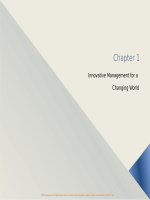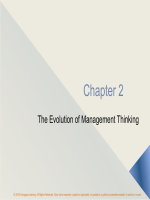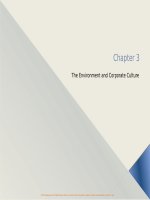Management 12e by w griffin ch15
Bạn đang xem bản rút gọn của tài liệu. Xem và tải ngay bản đầy đủ của tài liệu tại đây (1.68 MB, 44 trang )
TWELFTH EDITION
MANAGEMENT
Ricky W. Griffin
Part Five: The Leading
Process
Chapter Fifteen: Managing Employee
Motivation and Performance
© 2017 Cengage Learning. All rights reserved. May not be copied, scanned, or duplicated, in whole or in part, except for use as permitted
in a license distributed with a certain product or service or otherwise on a password-protected website for classroom use.
15 - 1
Learning Outcomes
1. Characterize the nature of motivation, including its
importance and historical perspectives.
2. Identify and describe the major content perspectives
on motivation.
3. Identify and describe the major process perspectives
on motivation.
4. Describe reinforcement perspectives on motivation.
5. Identify and describe popular motivational strategies.
6. Describe the role of organizational reward systems in
motivation.
© 2017 Cengage Learning. All rights reserved. May not be copied, scanned, or duplicated, in whole or in part, except for use as permitted
in a license distributed with a certain product or service or otherwise on a password-protected website for classroom use.
15 - 2
The Nature of Motivation
Motivation
– is the set of forces that cause people to
behave in certain ways.
Importance of motivation in the workplace
– Factors determining individual performance:
• Motivation – the desire to do the job.
• Ability – the capability to do the job.
• Work environment – resources to do the job.
– Motivation is intangible in character.
© 2017 Cengage Learning. All rights reserved. May not be copied, scanned, or duplicated, in whole or in part, except for use as permitted
in a license distributed with a certain product or service or otherwise on a password-protected website for classroom use.
15 - 3
Figure 15.1
The Motivation Framework
© 2017 Cengage Learning. All rights reserved. May not be copied, scanned, or duplicated, in whole or in part, except for use as permitted
in a license distributed with a certain product or service or otherwise on a password-protected website for classroom use.
15 - 4
Historical Perspectives on Motivation
The traditional approach (Frederick Taylor)
advocates incentive pay systems.
– This narrow view fails to consider other factors.
The human relations approach emphasizes
the role of social processes in the workplace.
– Give employees the illusion of involvement.
The human resource approach goes past the
illusion, looking for real employee
contributions.
© 2017 Cengage Learning. All rights reserved. May not be copied, scanned, or duplicated, in whole or in part, except for use as permitted
in a license distributed with a certain product or service or otherwise on a password-protected website for classroom use.
15 - 5
Content Perspectives on Motivation
Content perspectives
Are approaches to motivation that
address the question: What factor
or factors in the workplace motive
people?
© 2017 Cengage Learning. All rights reserved. May not be copied, scanned, or duplicated, in whole or in part, except for use as permitted
in a license distributed with a certain product or service or otherwise on a password-protected website for classroom use.
15 - 6
The Needs Hierarchy Approach
Two needs hierarchy approaches are
Maslow’s hierarchy and the ERG theory.
Maslow’s hierarchy of needs
– suggests that people must satisfy five groups
of needs in order:
•
•
•
•
•
physiological,
security,
belongingness,
esteem, and
self-actualization.
© 2017 Cengage Learning. All rights reserved. May not be copied, scanned, or duplicated, in whole or in part, except for use as permitted
in a license distributed with a certain product or service or otherwise on a password-protected website for classroom use.
15 - 7
Figure 15.2
Maslow’s Hierarchy of Needs
© 2017 Cengage Learning. All rights reserved. May not be copied, scanned, or duplicated, in whole or in part, except for use as permitted
in a license distributed with a certain product or service or otherwise on a password-protected website for classroom use.
15 - 8
The Needs Hierarchy Approach
ERG theory of motivation
– suggests that people’s needs are grouped into
three possibly overlapping categories:
• existence, relatedness, and growth.
– This theory collapses Maslow into three levels.
• Existence – physiological and security needs.
• Relatedness – need to belong and earn esteem.
• Growth – self-esteem and self-actualization.
– A frustration-regression element allows a person
to back down the hierarchy when frustrated.
© 2017 Cengage Learning. All rights reserved. May not be copied, scanned, or duplicated, in whole or in part, except for use as permitted
in a license distributed with a certain product or service or otherwise on a password-protected website for classroom use.
15 - 9
The Two-Factor Theory
Two-factor theory of motivation
– people’s satisfaction and dissatisfaction are
influenced by two independent set of factors –
motivation factors and hygiene factors.
– Herzberg concluded satisfaction and
dissatisfaction were not at opposite ends of a
continuum, but on different continuums.
• Motivation factors fell on the satisfaction continuum.
• Hygiene factors fell on the dissatisfaction continuum.
© 2017 Cengage Learning. All rights reserved. May not be copied, scanned, or duplicated, in whole or in part, except for use as permitted
in a license distributed with a certain product or service or otherwise on a password-protected website for classroom use.
15 - 10
Figure 15.3
The Two-Factor Theory of Motivation
Herzberg recommended job enrichment.
© 2017 Cengage Learning. All rights reserved. May not be copied, scanned, or duplicated, in whole or in part, except for use as permitted
in a license distributed with a certain product or service or otherwise on a password-protected website for classroom use.
15 - 11
Content Perspectives on Motivation
Three important individual human needs
– The need for achievement is the desire to
accomplish a goal or task more effectively than in the
past.
– The need for affiliation is the desire for human
companionship and acceptance.
– The need for power is the desire to be influential in a
group and to control one’s environment.
The implications of content perspectives is that
they discuss what motivates people, but do not
describe how people are motivated.
© 2017 Cengage Learning. All rights reserved. May not be copied, scanned, or duplicated, in whole or in part, except for use as permitted
in a license distributed with a certain product or service or otherwise on a password-protected website for classroom use.
15 - 12
Process Perspectives on Motivation
Process perspectives
• Focus on why people choose certain
behavioral options to fulfill their needs and
how they evaluate their satisfaction after they
have attained these goals.
Process perspectives are concerned with how
motivation occurs.
© 2017 Cengage Learning. All rights reserved. May not be copied, scanned, or duplicated, in whole or in part, except for use as permitted
in a license distributed with a certain product or service or otherwise on a password-protected website for classroom use.
15 - 13
Process Perspectives on Motivation
• Suggests that motivation
depends on two things: how
much we want something and
how likely we think we are to
get it.
Expectancy
theory
© 2017 Cengage Learning. All rights reserved. May not be copied, scanned, or duplicated, in whole or in part, except for use as permitted
in a license distributed with a certain product or service or otherwise on a password-protected website for classroom use.
15 - 14
Figure 15.4
The Expectancy Model of Motivation
© 2017 Cengage Learning. All rights reserved. May not be copied, scanned, or duplicated, in whole or in part, except for use as permitted
in a license distributed with a certain product or service or otherwise on a password-protected website for classroom use.
15 - 15
Expectancy Theory
Expectancy theory has four assumptions
– Behavior is determined by a combination of
forces in the individual and in the environment.
– People make decisions about their own
behavior in organizations.
– Different people have different types of needs.
– People make choices from alternative plans of
behavior, based on perceptions of the extent a
given behavior will lead to desired outcomes.
© 2017 Cengage Learning. All rights reserved. May not be copied, scanned, or duplicated, in whole or in part, except for use as permitted
in a license distributed with a certain product or service or otherwise on a password-protected website for classroom use.
15 - 16
Expectancy Theory
Expectations in expectancy model
– Effort-to-performance expectancy
• is the individual’s perception of the probability that
effort will lead to high performance.
– Performance-to-outcome expectancy
• is the individual’s perception that performance will
lead to a specific outcome.
– Outcomes
• are consequences of behaviors in an organization
setting, usually rewards.
© 2017 Cengage Learning. All rights reserved. May not be copied, scanned, or duplicated, in whole or in part, except for use as permitted
in a license distributed with a certain product or service or otherwise on a password-protected website for classroom use.
15 - 17
Expectancy Theory
Expectations in expectancy model
– Each outcome has an associated value or
valance.
– A valance
• is an index of how much an individual desires a
particular outcome, the attractiveness of the outcome.
For motivation to occur
– all of the following must be greater than 0.
• Effort-to-performance, performance-to-outcome, and
the sum of the valences for the outcomes.
© 2017 Cengage Learning. All rights reserved. May not be copied, scanned, or duplicated, in whole or in part, except for use as permitted
in a license distributed with a certain product or service or otherwise on a password-protected website for classroom use.
15 - 18
Expectancy Theory
The Porter-Lawler extension
– suggests that high performance may lead to
satisfaction that results from the rewards
given for high performance.
This reverses the direction of causation
– Expectancy theory says motivated workers
will have high performance.
– Porter-Lawler say that high performing
workers will become motivated.
© 2017 Cengage Learning. All rights reserved. May not be copied, scanned, or duplicated, in whole or in part, except for use as permitted
in a license distributed with a certain product or service or otherwise on a password-protected website for classroom use.
15 - 19
Figure 15.5
The Porter-Lawler Extension of Expectancy Theory
© 2017 Cengage Learning. All rights reserved. May not be copied, scanned, or duplicated, in whole or in part, except for use as permitted
in a license distributed with a certain product or service or otherwise on a password-protected website for classroom use.
15 - 20
Process Perspectives on Motivation
• Suggests that people are motivated to
seek social equity in the rewards they
receive for performance.
Equity theory
© 2017 Cengage Learning. All rights reserved. May not be copied, scanned, or duplicated, in whole or in part, except for use as permitted
in a license distributed with a certain product or service or otherwise on a password-protected website for classroom use.
15 - 21
Equity Theory
To determine equity
– a person compares their ratio of outcomes to
inputs to someone else’s ratio.
– Formulation of ratios and comparisons are
very subjective, based on perceptions.
– May result in feelings of equitable rewards,
under-rewarded, or over-rewarded.
– If inequality is perceived, employee works to
correct the imbalance.
© 2017 Cengage Learning. All rights reserved. May not be copied, scanned, or duplicated, in whole or in part, except for use as permitted
in a license distributed with a certain product or service or otherwise on a password-protected website for classroom use.
15 - 22
Goal-Setting Theory
Goal setting theory of motivation
– assumes behavior is a result of conscious
goals and intentions.
– Original theory
• Goal difficulty – challenging and requires effort.
• Goal specificity – clarity and precision of goal.
– Expanded theory
• Goal acceptance – makes goals their own.
• Goal commitment - wants to reach the goal.
© 2017 Cengage Learning. All rights reserved. May not be copied, scanned, or duplicated, in whole or in part, except for use as permitted
in a license distributed with a certain product or service or otherwise on a password-protected website for classroom use.
15 - 23
Figure 15.6
The Expanded Goal-Setting Theory of Motivation
Because the theory attracted so much
interest, an expanded model was proposed.
© 2017 Cengage Learning. All rights reserved. May not be copied, scanned, or duplicated, in whole or in part, except for use as permitted
in a license distributed with a certain product or service or otherwise on a password-protected website for classroom use.
15 - 24
Process Perspectives on Motivation
Implications of the process perspectives
– Managers trying to improve motivation can
use steps to achieve the expectancy theory.
– Managers need to consider the nature of the
‘other’ employees compare themselves to.
– Goal-setting theory can be used to implement
both expectancy and equity theory concepts.
© 2017 Cengage Learning. All rights reserved. May not be copied, scanned, or duplicated, in whole or in part, except for use as permitted
in a license distributed with a certain product or service or otherwise on a password-protected website for classroom use.
15 - 25









